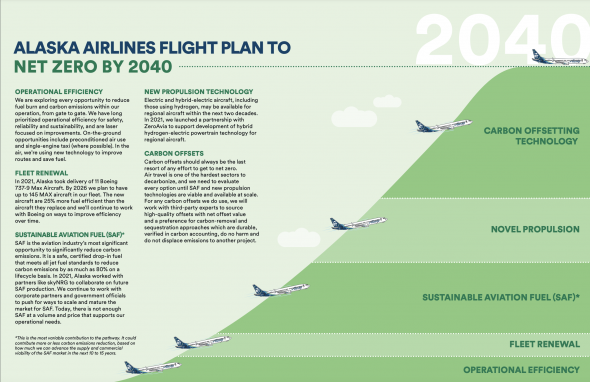NEWSLETTER
In Conversation: Holly Boyd-Boland, Virgin Atlantic

At the end of April, Alaska Airlines released its annual sustainability report.
This includes more details on how it intends to reach net zero by 2040.
That makes Alaska Airlines one of a small number of airlines working to a faster timetable than the official IATA target of 2050 (another is JetBlue).
To reach that goal, first of all the airline is looking at fuel consumption.
This involves a combination of a fleet renewal programme and over time buying sustainable aviation fuel (SAF). Alaska Airlines is also bringing ‘operational efficiencies’ for example, in take off / landing procedures.
Then there is carbon offsetting.
Alaska Airlines calls this, “the last resort of any effort to get to net zero”, saying that the airline will “need to evaluate every option until SAF and new propulsion technologies are viable and available at scale”.
The airline has also made a big commitment to invest in new technology.
Here, Alaska Airlines is working with ZeroAvia to develop hydrogen-electric engine powered aircraft (United is another ZeroAvia investor).
And, through its Alaska Star Ventures Fund, Alaska Airlines has invested in other ventures, including in Up Partners, which develops new mobility solutions. This includes Beta Technologies, which is working on eVTOL vehicles
The Net Zero Dish
One way to think of “airline net zero” is as a dish, where you have set ingredients.
So the ‘ingredients’ Alaska Airlines is using to reach net zero are really the same as other airlines:
Fleet renewal + operational efficiency + carbon offsetting + SAF + new technologies (e.g. hydrogen-electric aircraft)
For example, Ryanair talked about the exact same points when it recently outlined its own plans to reach net zero by 2050.
But if we take our analogy further, the ingredients might be the same, but the quantities differ on an airline by airline basis.
So, both Alaska and JetBlue are putting more emphasis on new technology, backed up by actual investments in promising ventures. Like JetBlue, Alaska Airlines also stresses the importance of SAF.
Other airlines following the 2050 as opposed to 2040 target date might put more of a focus on carbon offsetting and on getting rid of older aircraft.
However, the emphasis that an airline puts on each part of these five elements does seem to give a clue as to how quickly they will reach net zero, and also how ‘green’ their plans really are.
SimpliFlying CEO Shashank Nigam writes:
Two weeks ago, we launched our new podcast – Sustainability In The Air, with new interviews with industry and airline CEOs every Thursday. Thanks for the 💖.
It doesn’t matter if we win awards – what matters is what *you* are. saying.
Your reviews on podcast platforms, the comments on LinkedIn posts and even on Twitter have been humbling.
Thanks so much for leaving the first reviews Dan Nevill, Christy Sarkis and David Studden ✈ – we’ve planted over 150 trees in just the past week in Mozambique in your honour, thanks to CarbonClick!
We’re two episodes in and have 8 more to go this season.
The entire #Simpliteam is very excited.
We welcome all feedback, so please keep it coming. Do share the podcast with your friends and colleagues too!
Positive story of the day
Delta spotlights sustainable heights on recent flight (Delta Newsroom)
Carbon-neutral options for Lufthansa’s flights (Travel Wires)
Kenyan carrier rolls out ‘green’ flights plan (Business Daily Africa)
easyJet Forms New Partnership To Accelerate Aviation’s Hydrogen Adoption (Simple Flying)
Southwest Airlines’ Flight Path To Carbon Neutrality (Forbes)
From Here to There: Challenges in meeting sustainable aviation fuel targets (White & Case)
How do Sustainable Aviation Fuels work and are they a viable alternative? (Euronews Travel)
SAF ‘not a silver bullet’, warns Carbon Thrust founder (Travel Weekly)